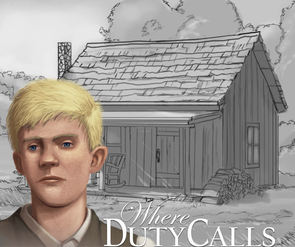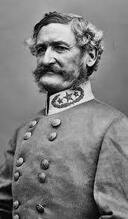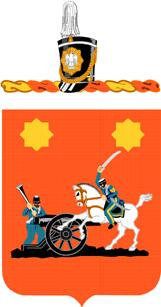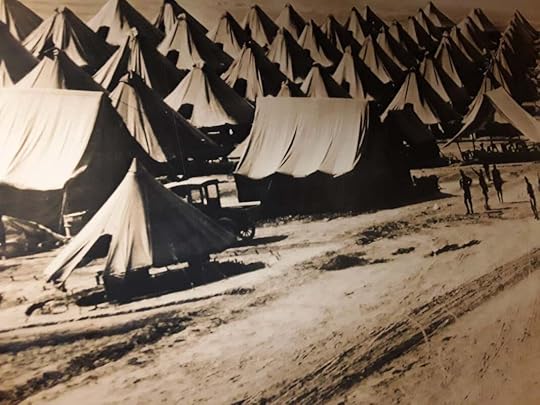A General with a Plan
 Jemmy and his home, as depicted by illustrator Ian Barstow The main character Where Duty Calls, my Civil War novel set in New Mexico, is Jemmy Martin, a gentle farm boy from San Antonio, Texas. Jemmy loves his humble home and his family, but has a very special relationship with the farm animals, especially the two mules.
Jemmy and his home, as depicted by illustrator Ian Barstow The main character Where Duty Calls, my Civil War novel set in New Mexico, is Jemmy Martin, a gentle farm boy from San Antonio, Texas. Jemmy loves his humble home and his family, but has a very special relationship with the farm animals, especially the two mules. Jemmy's brother, Drew, is a little flightier. When Drew sneaks into town to join the Confederate army, Jemmy is tasked with finding him and bringing him back. While he is in town, a group of riders passes, and Jemmy is impressed:
 "At their center was a fine-looking man with silver hair that caught the morning sun and made him look as if a halo circled his head. He had a great, bushy mustache, sideburns, and sad, drooping eyes that made Jemmy feel as if this man had seen all the sorrow the world had to offer and had learned how to push through it. Jemmy instantly felt as if he could follow the man anywhere." The fine-looking man that had impressed Jemmy so well was Confederate Brigadier General Henry H. Sibley, and while Jemmy Martin is a figment of my imagination, General Sibley was a real person who impressed many. Several contemporary records attest to his natural charisma and ability to inspire people with his words.
"At their center was a fine-looking man with silver hair that caught the morning sun and made him look as if a halo circled his head. He had a great, bushy mustache, sideburns, and sad, drooping eyes that made Jemmy feel as if this man had seen all the sorrow the world had to offer and had learned how to push through it. Jemmy instantly felt as if he could follow the man anywhere." The fine-looking man that had impressed Jemmy so well was Confederate Brigadier General Henry H. Sibley, and while Jemmy Martin is a figment of my imagination, General Sibley was a real person who impressed many. Several contemporary records attest to his natural charisma and ability to inspire people with his words.
 The coat of arms of the 2nd Dragoons Henry Hopkins Sibley' came from a family that had served the United States since its inception. His grandfather, Dr. John Sibley, was a medical assistant in the Revolutionary War. When the war was over, he continued his training and became a surgeon. In 1803, after the United States bought the Louisiana Purchase, he left his native Massachusetts and joined an expedition to the Red River country of western Louisiana. He liked the new territory so well that he moved to Natchitoches, Louisiana, where he worked as a contract surgeon and was an Indian Agent for New Orleans. John Sibley also served as a Senator in the Louisiana State Senate, and was a colonel in the local militia, a cattle farmer, a cotton planter, and a salt manufacturer. His son Samuel Sibley served as a parish clerk.
The coat of arms of the 2nd Dragoons Henry Hopkins Sibley' came from a family that had served the United States since its inception. His grandfather, Dr. John Sibley, was a medical assistant in the Revolutionary War. When the war was over, he continued his training and became a surgeon. In 1803, after the United States bought the Louisiana Purchase, he left his native Massachusetts and joined an expedition to the Red River country of western Louisiana. He liked the new territory so well that he moved to Natchitoches, Louisiana, where he worked as a contract surgeon and was an Indian Agent for New Orleans. John Sibley also served as a Senator in the Louisiana State Senate, and was a colonel in the local militia, a cattle farmer, a cotton planter, and a salt manufacturer. His son Samuel Sibley served as a parish clerk.Henry Hopkins Sibley was born in Natchitoches in 1816. His father, Samuel, died when he was only seven years old, after which lived with an uncle and aunt in Missouri. He was admitted to West Point when he was seventeen, and when he graduated in 1838, he was commissioned as second lieutenant in the 2nd U.S. Dragoons. Between 1840 and 1860 he fought Seminole Indians in Florida, served on the Texas frontier, fought in the Mexican–American War, was involved in trying to control conflict in Bleeding Kansas and quelling a Mormon uprising in Utah. In 1857, Sibley was assigned active service protecting settlers from Navajo and Apache attacks in New Mexico.
 During the 1850s, Sibley invented and patented a tent and stove for military purposes. The "Sibley tent", which was inspired by the teepees of Native American Plains Indians, was widely used by both the Union Army and Confederate Armies during the Civil War. The conical Sibley tent stove, pictured on the right side of this tent, was used by the Army into the early years of the second World War. Despite the popularity of both of these inventions, Sibley received little remuneration for them.
During the 1850s, Sibley invented and patented a tent and stove for military purposes. The "Sibley tent", which was inspired by the teepees of Native American Plains Indians, was widely used by both the Union Army and Confederate Armies during the Civil War. The conical Sibley tent stove, pictured on the right side of this tent, was used by the Army into the early years of the second World War. Despite the popularity of both of these inventions, Sibley received little remuneration for them.  Sibley tents in Camp Columbus, NM in 1916 during the build-up to the Punitive Expedition. The lower skirts have been removed from the one in the foreground to keep the air inside cool. At the time that the Civil War began, Sibley was stations at Fort Union, in northern New Mexico. Like many soldiers who had been raised in the south, he resigned his commission to join the Confederate Army. Sibley resigned on May 13, 1861, the same day he was promoted to major in the 1st Dragoons. Had he not left, he would have been offered the command of the military department of New Mexico, since the man who had held that position, Colonel William Wing Loring, had also left to take a southern commission.
Sibley tents in Camp Columbus, NM in 1916 during the build-up to the Punitive Expedition. The lower skirts have been removed from the one in the foreground to keep the air inside cool. At the time that the Civil War began, Sibley was stations at Fort Union, in northern New Mexico. Like many soldiers who had been raised in the south, he resigned his commission to join the Confederate Army. Sibley resigned on May 13, 1861, the same day he was promoted to major in the 1st Dragoons. Had he not left, he would have been offered the command of the military department of New Mexico, since the man who had held that position, Colonel William Wing Loring, had also left to take a southern commission. Sibley took a stagecoach out of New Mexico. A diary of a Union soldier stationed in Albuquerque says that, while passing through in a stagecoach, Sibley stuck his head out the window and shouted “Boys, I'm the worst enemy you have!”
He passed through Texas and Louisiana on his way to Richmond, Virginia, where he talked Jefferson Davis, the President of the Confederate States, into commissioning him as a brigadier general. Davis authorized him to recruit a brigade of volunteers in central and south Texas. Sibley’s plan was to march to El Paso, then occupy New Mexico. From there, he would seize the rich mines of Colorado Territory, turn west through Salt Lake City, and capture the seaports of Los Angeles and San Diego and the California goldfields.
Sibley's battle cry, “On to California!” inspired 2,000 men to join his campaign. By early fall of 1861, Sibley had three regiments of what he named The Army of New Mexico, plus artillery and supply units, camped on the outskirts of San Antonio. One of them, at least in my story, was Jemmy Martin.
 Where Duty Calls is the first in a trilogy of novels set in New Mexico during the Civil War and written for middle grade readers. It is scheduled to be published by Kinkajou Press, a division of Artemesia Publishing, on June 14, 2022.
Where Duty Calls is the first in a trilogy of novels set in New Mexico during the Civil War and written for middle grade readers. It is scheduled to be published by Kinkajou Press, a division of Artemesia Publishing, on June 14, 2022.It is available for preorder here.
Jennifer Bohnhoff is a former New Mexico history teacher. She is a native New Mexican and lives in the mountains east of Albuquerque.
Published on February 21, 2022 23:00
No comments have been added yet.



